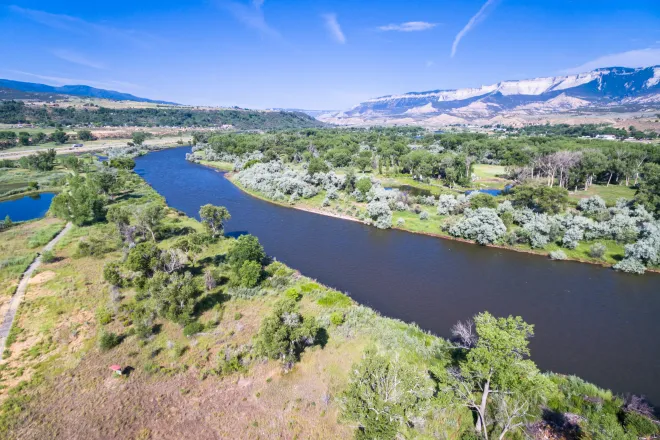
Officers rescue 69 people being held in Albuquerque stash house
(The Center Square) – As a record number of foreign nationals are entering the U.S. illegally through the El Paso Sector, which includes all of New Mexico and two west Texas counties, law enforcement officers are continuing to uncover stash houses being used in human smuggling operations.
Homeland Security Investigations special agents and Albuquerque Police Department’s VICE Unit rescued 69 people who were smuggled into New Mexico and then held against their will inside a stash house.
They included mostly adults and five unaccompanied minors. The majority were Guatemalans; eight were Mexicans, two El Salvadorans and one each was from Ecuador and Honduras. Their ages ranged from 14 to 46-years-old.
The smuggler, Rolando Joaquin-Miguel, a 35-year-old Guatemalan who was in the U.S. illegally, was arrested on Nov. 29, Immigration and Customs Enforcement announced on Wednesday.
He was charged with human smuggling and hostage taking in the District of New Mexico and is being held without bond pending judicial proceedings in federal court.
The APD detectives and HSI special agents who uncovered the stash house are members of the New Mexico Human Trafficking Task Force. Albuquerque Police Chief Harold Medina said the city’s detectives responded to a tip. Because they worked quickly, he said, they “likely saved lives, making this operation a success.” He also said it was the second time the APD has disrupted a large-scale human smuggling operation involving victims from Central America.
After obtaining warrants and conducting undercover surveillance, officers observed people delivering large amounts of takeout to a trailer home on the 9000 block of Zuni Road Southeast in Albuquerque. They then discovered that 69 people were being held inside.
It’s unknown how long they were held, but ICE reported they appear to have been held for less than 30 days. Once rescued, they were offered victim services and support from a local nongovernmental organization.
“Thanks to the outstanding work of HSI and our local partners, we were able to rescue these people who were being treated as merchandise and victimized for profit,” HSI El Paso special agent in charge Francisco B. Burrola said, adding that HSI would “continue to work aggressively to combat these egregious crimes and go after the people and transnational criminal organizations involved.”
The transnational criminal organization he’s likely referring to is the Sinaloa Cartel, which maintains operational control of the U.S-Mexico border from California to roughly the Big Bend area of Texas, including Brewster County. The Sinaloa is currently warring with factions and other cartels for control over access to El Paso, Texas.
The stash house was in the El Paso CBP Sector, which is seeing record numbers of people illegally entering the U.S. as cartels move their trafficking routes to bring in more people and drugs, anticipating the end of Title 42 at the end of the month.
The sector covers 264 miles of international boundary, including 121,000 square miles in New Mexico and 4,500 square miles in Texas. Border Patrol agents tasked with patrolling an expansive desert and mountainous-like terrain have increasingly been taken off the line of defense to process an unprecedented number of people illegally entering from all over the world.
According to preliminary U.S. Customs and Border Protection data, El Paso BP Sector agents apprehended 53,574 people from all over the world in November. When the documented gotaway number of 24,124 is added, the total climbs to 77,698.
Despite lawsuits over the administration’s reversal of detention and deportation policies, BP agents have been instructed by the Biden administration to release into the U.S. most of those they apprehend, agents say.
The preliminary data excludes Office of Field Operations data, meaning the official numbers, once released, will be higher, although CBP doesn’t make the gotaway data public.
“Gotaways” is the official term used by Border Patrol to describe foreign nationals who enter the U.S. illegally and don’t surrender at ports of entry but intentionally seek to evade capture from law enforcement. The recorded number only includes those whom agents verify escape; it doesn’t include those they don’t see – like those entering at night on private property or those who clear their tracks. It also doesn’t include the untold number being smuggled in vehicles who aren’t stopped at checkpoints or on highways and county roads. The gotaway number is always considered to be significantly higher than what’s reported, law enforcement officers and Border Patrol agents have said.
The number of those who were apprehended and evaded capture in the El Paso Sector in November alone was greater than the individual populations of 421 out of 425 cities in New Mexico and greater than the individual populations of 28 of 33 counties, according to 2022 Census data.
Excluding Albuquerque and Las Cruces, the number of illegal foreign nationals apprehended and who got away in November total more than the combined populations of towns where El Paso Sector NM Border Patrol stations are located: Alamogordo (30,998), Deming (14,738), Lordsburg (2,243), Truth or Consequences (5,968), and Santa Teresa (5,202).
The number of illegal entries is only expected to climb exponentially.
While Texas Gov. Greg Abbott launched a cartel interdiction effort to secure the Texas-Mexico border through Operation Lone Star, New Mexico’s Democratic governor has taken no such action.
Since last March, Texas’ OLS officers have apprehended over 328,000 illegal foreign nationals and made more than 22,100 criminal arrests, with more than 19,600 felony charges reported. They’ve also seized over 353 million lethal doses of fentanyl in Texas alone, enough to kill everyone in the United States.

















